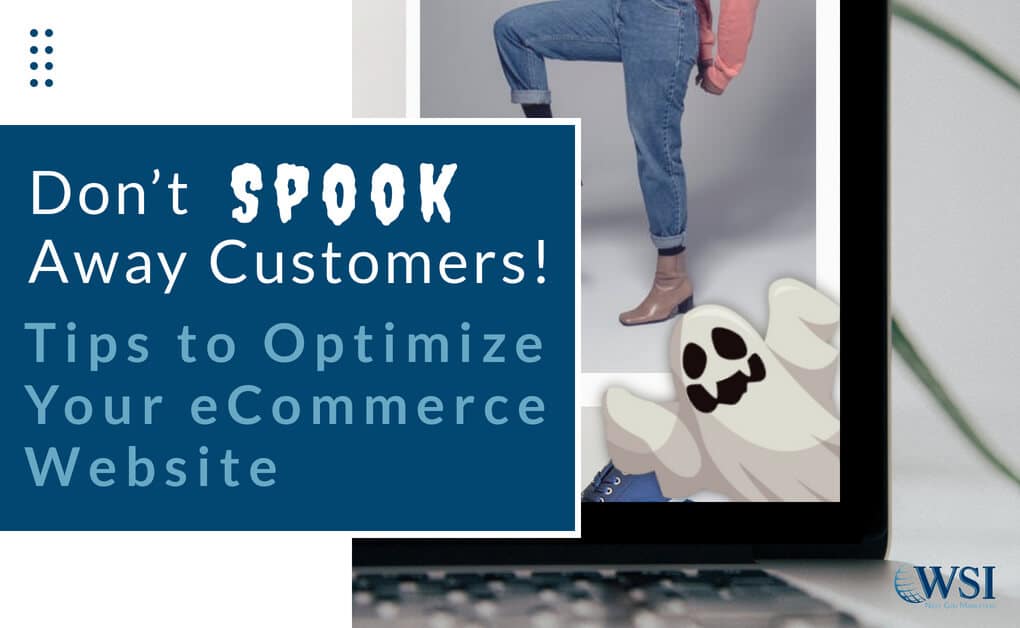Don’t Spook Away Customers: Tips to Optimize Your eCommerce Website!
October is here and the highly anticipated Halloween is looking very different this year. We’re big fans of this holiday and while we encourage getting into the scary spirit at home, we don’t recommend scaring potential customers with bad website practices – especially if your goal is to sell online. Start thinking about your online store – is every visitor converting? Where is there room for improvement?
Don’t spook away customers and check out these tips to optimize your eCommerce website (Halloween edition)!
Perfect Your Product Pages
Product pages are the lifeline (or bloodline according to Dracula) of your store. If users have landed on a product page, they’ve already sunk their teeth in and are ready to take a bite. Ensure the page is built in a user-friendly way and easily displays all relevant information needed to make a sale.
Breadcrumbs
Adding breadcrumbs based on product hierarchy and history is the first step to creating this user flow. This makes it easy for users to go back to the category they were shopping in without hitting the browser back button and getting lost. Amazon uses this tactic on each product page.
Product Titles
The title of each product page is essential too. How descriptive and SEO-friendly are your product titles? Is it time for a re-vamp? Consider using more specific and descriptive titles so the product pages can rank on search engines and shoppers can easily find what they need.
Product Descriptions
Another key area that may require a second look. A proper product page should include an area with product specification (dimensions, weight, visual description, etc), reviews from customers who have bought the item with the ability to post pictures, and any other industry specific details that are important to your customers. For example, wineries may feature Winemaker and Vintage tabs in their description sections.
Product Images
This is most likely led the shoppers to click on the product. Think about your products and what your customers want to see. If you’re selling clothing or shoes, consider showing images of the items by themselves as well as on a model. Videos are also a great way to give customers a better idea of what they’re buying and using customer photos can help shoppers see the items in real life.
CTA
A quick note about calls-to-action: make sure your buttons are nice and bright. “Shop,” “Add to Cart,” and “Purchase” buttons should be easy to see and attractive to click. Bright colors say “Click me!” while dull, grey buttons say, “sold out,” “not available,” and “this product sucks, don’t buy it.”
Reducing Cart Abandonment
This is by far the spookiest statistic: according to Baymard Institute, the average cart abandonment rate for an eCommerce website is 69.57%. Let’s have a moment of silence for all the lost sales.
Checkout Steps
One of the most common reasons this tragedy occurs is from too many steps in the checkout process. Users expect to quickly type in shipping and credit card info but instead are taken through a journey of never-ending fields – like a haunted house with no exit. Did you know most payment processors don’t require a billing address? This is just one set of fields that can be deleted in the checkout process.
Does your checkout involve clicking “next” on more than two pages? Shoppers like to see how much info they need to provide – and if they must click “next” there should be a “back” button without having to click the browser’s back button and lose their work.
Multiple Payment Options & One-Step Payments
The motherload. This is where most of us have made impulse buying decisions and came home to 17 boxes of products we didn’t need. In all seriousness, providing easy payment methods like Paypal, Google Pay, Apple Pay, and Venmo can lead to immediate purchases.
Guest Checkout
Be sure to always offer guest checkout and not force shoppers to sign in to make purchases. Baymard Institute found that 37% of people abandon cart because they don’t want to create an account. Some industries may require sign in – in that case, shoppers usually know to expect this.
Shipping & Fees
Another way to reduce cart abandonment is to remove the shipping and fees shock. Be upfront with your customers and let them know what they’re getting into before checkout. Often times, it’s simply the shock of seeing the added fees that triggers the sale abandonment. If the shopper is shown an estimate ahead of time, they won’t be surprised and they’ll be happier to complete the purchase.
If you can afford to, offer free-shipping – it’s one of the top incentives for shopping online. Some companies offer free-shipping after a certain purchase amount which is another great incentive to shop more
Keep a Visible Cart
This one’s pretty simple. Just keep the cart icon visible at all times. That’s it.
Use Coupons
Coupons are a major drive in making purchases. They can also be a great way to reel in customers – offer a first-purchase discount. Once they try your product and love it, they’ll come back and pay full price. You can also use coupons when customers are about to abandon their cart. Retarget customers who left items in their cart with a special offer they just can’t refuse.
Related Products & Upsell
One of the easiest and most effective tools you can use is “related” or “recommended” products. Research from Smart Insights found that over 60% of eCommerce revenue comes from recommending products with phrases like “visitors who viewed this product also viewed.” Apply this function to your store and watch your conversion rate transform as dramatically as a werewolf during a full moon. Well, maybe not that dramatically, but it will definitely help.
Compare Products
You can also encourage conversions by using a comparing feature. Amazon does this very well by featuring similar items in a chart, comparing their specific features and pricing. This is essentially a “related products” section but formatted in a comparison view.
Upsell
And if you want to increase revenue, try upselling. You can include upsells in your product pages, during checkout, and after checkout. For example, view a laptop product on the Apple website. You’ll see upsells for more processing power, memory, and storage. One way to modify this would be if Apple notes who these upsells would be ideal for, i.e. “For graphic designers and developers, we recommend…” Product tables are another great way to compare pricing across multiple products or services and allow you to upsell.
Mobile Optimize
Today, more people use mobile devices than desktops. Use your phone and head to your eCommerce website. Now, in Casper fashion, put yourself in your customer’s shoes and start shopping.
How long did your website take to load? More than 3 seconds and 40% of customers are gone. View the shop page. Are the images clear and attractive? Click on a product. Is the necessary information easy to find and is the add to cart button accessible without having to scroll too far down? Think about creating a “sticky” add to cart button that remains on screen as users scroll. Now add an item to cart – did you land straight into your cart or can you continue shopping easily. Perhaps you want to give your users the option to view cart or continue shopping. And finally, checkout. What does checkout look like on mobile? Do you have to click a lot of buttons before making the purchase? Is there an opportunity to offer Apple Pay, Venmo, or other mobile payment options?
We can’t stress the importance of mobile enough! Just a few years ago, people were searching for products and experiences on their phone and completing the purchases on desktop. Today, that’s all changed – mobile purchases are everything.
Don’t be a Basic Witch – Optimize Your eCommerce Website (in time for the holidays too!)
Having a great online store is more than just designing a BOO-tiful website. It’s about optimizing every aspect of the shopping process to increase conversions and revenue. 2020 has been one of the biggest years for eCommerce due to the pandemic shifting in-person shopping to online. And with holidays around the corner, shoppers will flood the Internet in search of the best deals. Now is the time to ensure your website is polished, your online store is optimized, and your marketing efforts are ready to retarget website visitors and advertise any holiday sales. And please, no grey buttons on your website. It’s ghoulish.
Get In Touch
Please select a valid form

